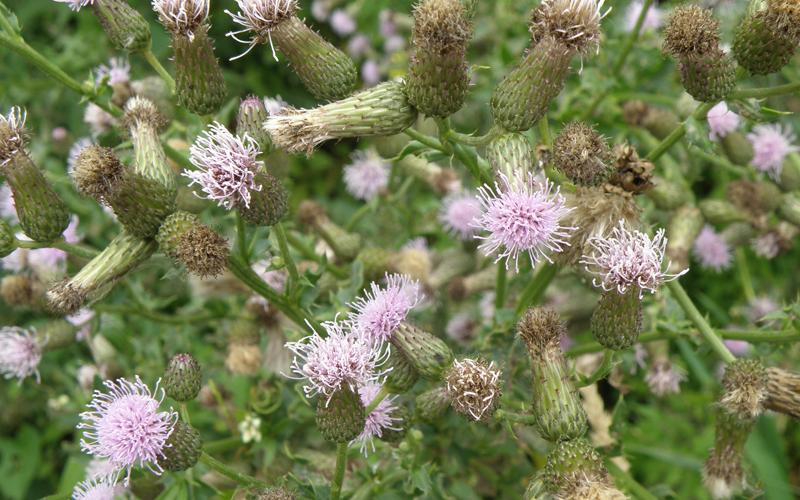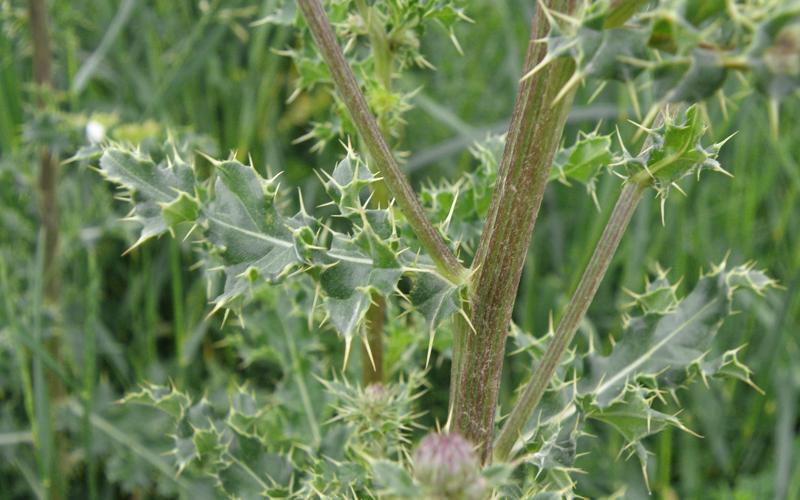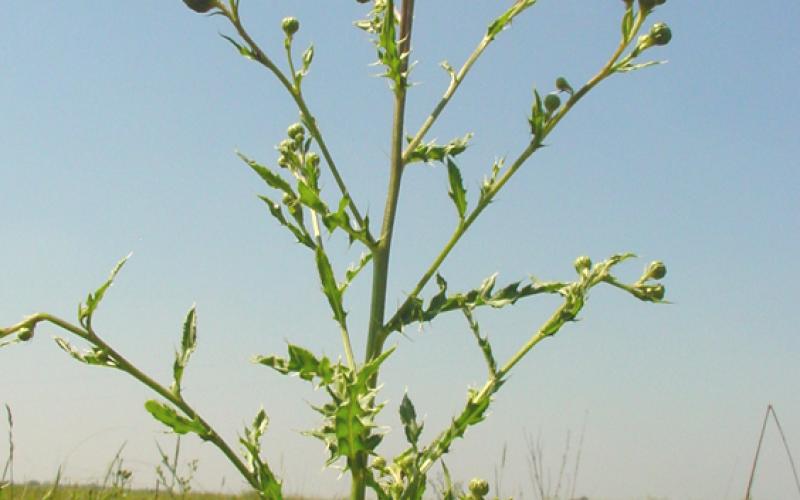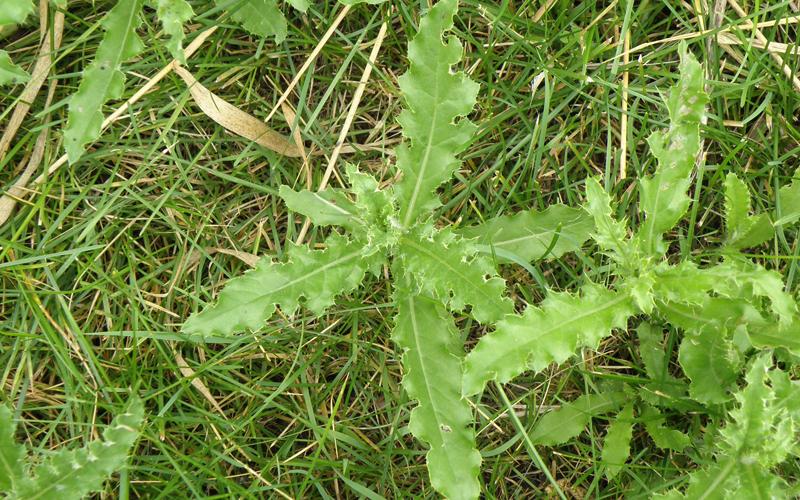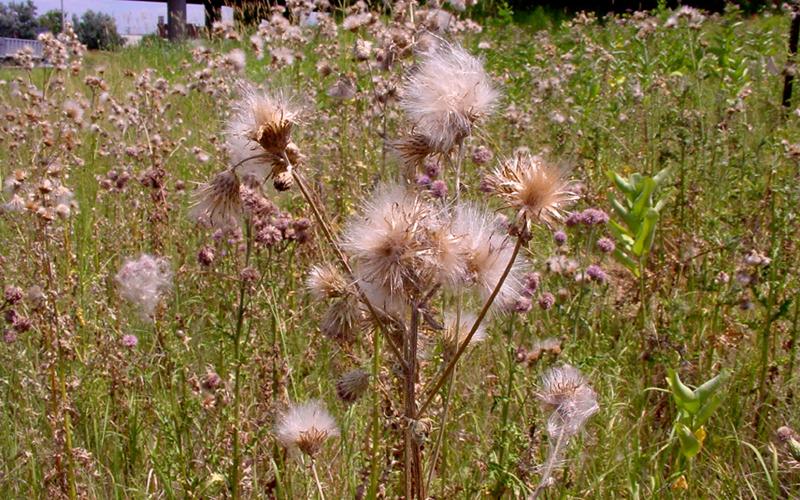Common Name: Canada Thistle
Scientific Name: Cirsium arvense (L.) Scop.
Legal Status
Efforts must be made to prevent seed maturation and dispersal of plants into new areas. Additionally, no transportation, propagation, or sale of these plants is allowed. Failure to comply may result in enforcement action by the county or local municipality.
Background
Canada thistle is native to Europe. It was introduced to North America in the 1600s, probably in agricultural seed shipments and is now widespread throughout the United States and Canada.
Description
- An aggressive perennial with a vigorous root system that continually produces new shoots, invading new areas and outcompeting other vegetation types.
- Grows 2 - 5 feet tall.
- Leaves are alternate, lance shaped, irregularly lobed, and have wavy spiny/toothed margins.
- Stems are usually smooth, but sometimes have short hairs and are slightly grooved.
- Flowers are purple and pink, occasionally white, and are borne at the end of the stems in clusters. Buds are 1/2 inch wide by 3/4 -1 inch long, have a tear-dropped shape, and lack spines.
- This plant is a prolific seed producer and also spreads by roots.
- Seedlings emerge as small rosettes in the fall or early spring, eventually bolting into erect branched flowering stems. Flowers begin to develop in late June, blooming between July and August.
- This plant is most recognizable in mid-July when flowers change to seedheads with obvious white fluffy tops. Seeds are attached to the "fluff" and can become airborne and spread to new areas.
Habitat
Found growing in a wide range of habitats. Typically infests a variety of disturbed landscapes and is commonly found along roadsides, trails, natural areas, pastures, forest and field margins, mining locations, waste areas and unmaintained gravel pits. This plant establishes quickly after new road construction, housing and development projects, overgrazing of pastures, forestry clear-cuts, and destructive flooding events.
Means of spread and distribution
Spreads primarily by rhizomes and seeds. Found commonly throughout Minnesota.
Impact
This plant is highly invasive, severely reduces pasture capacity and desirable forages, degrades wildlife habitat, and can hinder reforestation and landscape restoration efforts. Once a population gets established, it begins to quickly displace native vegetation, including desirable pollinator habitat, creating large stands with little biological diversity and low habitat value.
Prevention and management
- A sound management plan is necessary to manage this species and will take a commitment of several years to ensure that the population has decreased significantly and is not a serious problem. Because this is a perennial species that produces a lot of viable seeds, in addition to a vast underground network of spreading roots, management efforts must focus on both the prevention of seeds and eliminating root growth. Management plans that combine fall and early spring applications of specific foliar herbicides and pre-flower mowing throughout the growing season have shown to produce excellent results, especially when follow-up management occurs for several years until the population is significantly reduced. Restoration of treated sites by fostering existing or newly planted site-specific native plant species can also sustain management well into the future and prevent new populations from developing.
- Mowing or cutting of stands prior to flowering in late June can significantly reduce the overall seed production of a population. However, Canada thistle will continue to flower after mowing, so repeated attempts must be made throughout mid and late summer to prevent overall seed production. Mowing in a single year will not be sufficient to control large stands. Multiple years in succession will be required and it is important that any equipment used during the process is inspected and thoroughly cleaned to ensure that seeds are not being distributed to new areas.
- Fall and spring applications of foliar herbicides that mobilize their active ingredients into the root system of the plant have been shown to provide the most effective management. Infestations need to be monitored for several years after initial treatments and follow-up applications should be administered for surviving plants and new seedlings. If using herbicide treatments, check with your local University of Minnesota Extension Agent, co-op, or certified landscape care expert for assistance and recommendations. There are several businesses throughout the state with certified herbicide applicators that can be hired to perform chemical applications.
- Several biological control agents are commercially available. However, the results have been variable and non-target impacts not thoroughly tested. More information is needed at this time before these agents can be considered a viable means of control.
- Canada thistle lifecycle and treatment timing graphic
